Pages 6 & 7 of Feb. 7, 2017 Long Branch Guidelines Draft focuses on 3.3 Building Elements
Update:
A more complete and highly informative overview of the contents of the Feb. 7, 2017 Long Branch Urban Design Guidelines Draft Document is available at the website of Ward 6 Councillor Mark Grimes. We owe thanks to Councillor Grimes for the role that he and his office have played in the initiation and development of the Pilot Project.
Click here to access the overview at the Ward 6 Councillor’s website >
[End]

The first half of the Feb. 7, 2017 meeting of the Guidelines Advisory Group was devoted to presentations about the contents of the Guidelines Draft. Jaan Pill photo
We are now on pages 5 & 6 in a series that will end with pages 12 & 13.
Focus Questions
As noted at a previous post, the Feb. 7, 2017 meeting of the Long Branch Guidelines Community Advisory Group addressed a series of Focus Questions, namely:
1. Do you have any suggested refinements to the Long Branch Character Framework Plan?
What do you like about the draft guidelines?
How could they be improved?
3.2 Height & Massing
3.3. Building Elements
3.4 Driveways & Garages
3.5 Setbacks & Landscapes
3.6 Special Features
3. Are there any additional guidelines we should consider?
4. Do you have any suggestions for the approach / format for the public meeting?
[End]
3.3. Building Elements
I am posting each set of pages, roughly one set of pages per day, from the Long Branch Draft Reference Material (which are for discussion purposes only) that was distributed at the Feb. 7, 2017 meeting of the Community Advisory Group, and that will be available (if it’s not already posted) at the City of Toronto website.
Yesterday’s post was about 3.2 Height & Massing; today’s post is about 3.3 Building Elements.
3.3.2 Front Entrance Design
The introduction to page 6 reads:
Long Branch is characterized by a variety of entrance conditions but these are predominantly limited in height and situated close to street grade.
Front entrance designs should reinforce existing horizontal datums and the rhythm of facades along the street while providing active uses that serve to animate the public realm.
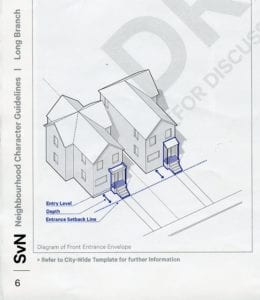
Diagram of Front Entrance Envelope for Objectives: 3.3 Building Elements. Note below image reads: Refer to City-Wide Template for further information. Source: Long Branch Draft (for discussion purposes only) Reference Material, Feb. 7, 2017, page 6 (detail)
The text for the Objectives for 3.3 Building Elements reads:
- Scale: Define a minimum / maximum envelope for the entrance (height, depth, width). An example of incompatibility is a full-facade portico in a street with lower porches/entrances
- Entry floor height: Identify appropriate entry floor heights. A common incompatibility is higher entrances with a subsequent larger stair area occupying a large share of the front entrance
- Massing: Define the type / level of enclosure of the entrance structure: colonnades, railings, parapet walls, etc. While flexibility in design is key to preserve the diversity and variety of a street, major incompatibilities should be avoided, such as a fully enclosed entrance structure in a street dominated by porches.
*
Click on each image to enlarge it; click again to enlarge it further
*
On page 6 you will find the following additional text:
*
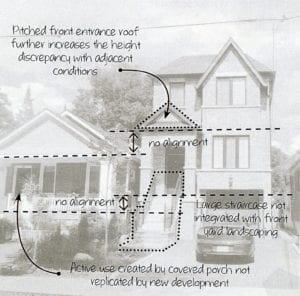
Figure 59. Incompatible front entrance design. Source: Long Branch Draft (for discussion purposes only) Reference Material, Feb. 7, 2017, page 7
How does the zoning regulate front entrance design?
While the zoning does not directly speak to front entrances, their design is directly influenced by regulations related to finished floor heights, driveways and garages as well as front yard landscaping.
The zoning regulates a maximum first floor height of 1.2 metres above established grade for detached and semi-detached dwellings and all residential zones are subject to a maximum vehicle entrance width of 6m (where the required minimum lot frontage is less than 24m).
What is the zoning’s intent?
The intent of these regulations is to establish a strong interface with adjacent streets, ensuring a sense of animation at street level, and to ensure that integral garages do not dominate the primary facade.
Long Branch is characterized by a variety of entrance conditions: decks, covered open and enclosed porches, steps, and flush entry ways. These entrances are predominantly situated close to established grade.
However, in some cases entrances are located significantly above grade, many with uncharacteristically tall front porch roofs.
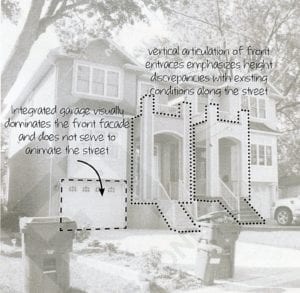
Figure 60. Incompatible front entrance design. Source: Long Branch Draft (for discussion purposes only) Reference Material, Feb. 7, 2017, page 7
Objectives
In other circumstances, integral garages are proportionately dominant and/or project well beyond the primary building entrance.
These conditions are incompatible with the prevailing character of Long Branch.
What are the key design guidelines?
In order to achieve the objectives related to scale, entry floor height and massing in the context of Long Branch, some key design guidelines include:
- Minimizing height of roofs associated with front entrances to reinforce existing horizontal datums along the street
- Integration of front entrance steps into the general front yard landscaping through the use of gradually sloped front lawns, raised planters and/or hedges in order to strengthen the perceived connection to grade
- Ensuring entrances face the street, are clearly visible, and proportioned to reinforce so as not to visually dominate the front facade.
A note at the page bottom reads:
See Character Defining Conditions > a., b., & f.
Please note: I have broken longer paragraphs into shorter ones, for ease in online reading.

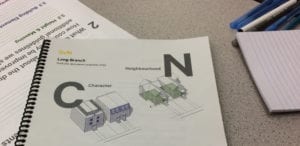
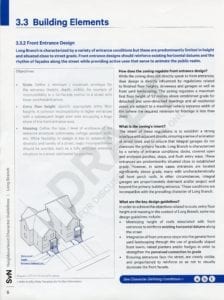
Leave a Reply
Want to join the discussion?Feel free to contribute!